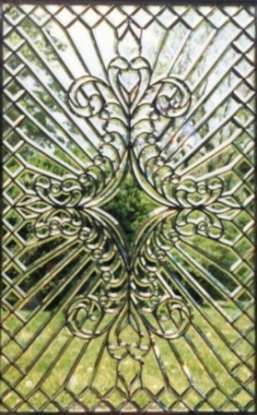

| These are just some of the beveled glass windows we have created using traditional designs in our Historical Collection. Some we make true to the originals, while others we embellish upon with various glass beveling techniques we’ve learned over the years. |

Being surrounded by sunlight helps us to create windows that match the
direction of the light they will receive in their final setting.

We are always looking for new ways to use glass. Painting, acid etching, carving,
beveling, lamp working… combining the materials from different sources and working
them in creative, never ending ways is a wonderful way to spend one’s life.

Sculpting solder with a 250 watt soldering iron. It is amazing how solder will
follow the heat and what one can achieve with patience and practice.

A cozy way to spend the day. Putty drying by the coal stove, radios on;
pushing putty around our stained glass windows can be a nice break from the stress of creativity.

To make our windows weather resistant, we push putty under all the leads.
This also gives the window much of its strength. Final cleaning is time consuming and tedious,
but gives the window a polished, finished look.
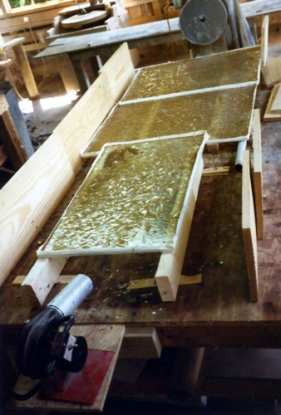
As the glue dries, it grasps the frosted glass and peals it to achieve the chip effect.
We always chip three times as much glass as we need so we can select for the effect we are trying to achieve.

Glue chipping is an old art glass process where one heats aminal glue in a double boiler
and pours in onto a level piece of glass that has been sandblasted. By varying the ratio of glue
to water and how many times we chip the glass we are able to achieve many different textures.

All five of my step children worked in the studio as they were growing up. My father took me to work
with him when I was a child, and as an adult I now consider it one of the most important parts of my life.
This is Matthew, another stepson, helping me cut a pattern.
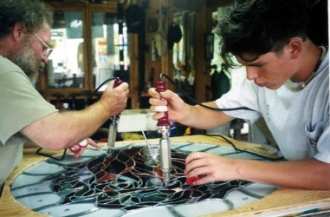
My stepson, Daniel White, has worked with me since he was a teenager. Now at, 30, we work together as
a team, learning from each other as he prepares to make our studio his life’s work. This partnership and
the passing of our art from one generation to another is the pinnacle of my career and gives me great joy.

After transforming our design to a rubber stencil on the glass, we cut the design with an exacto knife.
To achieve the depth and shadows for a landscape design such as this we carved with various mediums from fine to coarse.
Removing the stencil, carving, replacing the stencil, carving… we build on the process.

Sculpting with metal in our windows gives us the ability to create life-like forms like tree and vine motifs,
sometimes adding thorns and branches that protrude beyond the surface of the glass.
Here we use an electric hand-held melting pot to pour the base metal.

Documenting our projects as they develop for our archives and emailing updates to our clients.
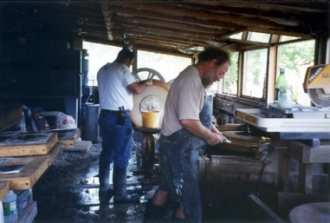
Hand beveling on our 1915 Henry Lang machinery. By holding the glass over rotating iron,
stone, cork, and felt, many small facetes are created to give the bevel its character.

By “waxing” the glass to an area of the studio where the light is the same as where the window will end up
is very important to the success of our projects. We also take into account the presence of trees or sky behind our windows.

Painting on glass is an art unto itself.
This is Missy Scott, one of the most gifted people I have ever worked with.

We created a wall 26′ x 9′ of cut mirror and black glass for a disco around 30 years ago.
You can see the design sketch in the photograph. By leaving the edge clean cut, the revolving
light would travel along the design lines.
 |
 |
 |
 |
 |
This is one of two large windows in which both of the wood frames had to be replaced. We braced the frames and removed each section of stained glass. Each window was carefully restored to revive the original beauty of the artist who created them.

For St. Paul’s we removed all of the yellowing plastic over the stained glass windows and replaced it with clear safety glass that will never fade or yellow. The stained glass windows were created almost 100 years ago by a German studio. Except for the two large windows, the stained glass was in excellent condition due to the level of craftsmanship and being protected from the elements by the plastic coverings.



This Historic Chapel, located on a private estate that dates back to before the Civil War, was being completely restored, and we were called in to repair and renew the artistic vision of the original stained glass windows. There were over 50 separate windows, each in a serious state of disrepair. We repainted each center panel, retouched numerous original pieces, and used UV resin to salvage as many broken pieces as possible. After re-leading, applying reinforcing bars, applying concrete putty, and completely cleaning each window, the final product was absolutely stunning.
To see the whole process unfold, please visit our Facebook page for Before and After photos and explanations.
 |
As churches grow and rebuild, they often take their stained glass windows with them. Here we removed one of the two original windows and restored it by cleaning, removing the bows, and bracing the sections. We then installed it into a light box in the new sanctuary and focused the light on the highlights of the window. |  |
 |
Southern exposure is hard on leaded glass. In this section of the home, the leaded glass was literally falling out of the sashes. We rebuilt the windows using the old glass and new, high quality lead came. |
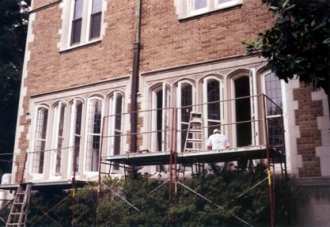 |
 |
The stained glass committee gave us this Icon to reproduce for their new chapel. One does not change an icon. We created the highlights for this window by acid etching European flash glass that is blown clean and dipped into a colored glass. The background was stippled onto a golden piece of glass to look like parchment. Glass jewels were used in the crown, surrounded by small pieces of beveled glass for highlights. The faces and hands we delicately painted throughout four firings in the kilns. |

One of our most spectacular projects is a pair of Rose Windows custom designed and created for the new St. Thomas Aquinas Priory in Charlottesville, Virginia. The Dominican Friars that live at the Priory will pray in the chapel where these windows live five times a day. Each symbol is placed to instruct the faithful and inspire prayer, which hearkens back to the purpose of stained glass in ancient times. Each individual painted piece was fired multiple times and painted using antique processes and techniques. The Dominicans are an old order, and new-style windows woulnd’t suit their new home.

To see more of this post, please visit our Facebook Page.
 |
 |
| Much of what we have learned comes from studying our historic windows. We were particularly drawn to this section of the 14th-century Eaton Bishop church in Herefordshire, England, because it represented a turning point in religious art. The Virgin no longer seems stiff as in earlier windows and is depicted with a supple, s-shaped form and lively facial expressions.
We created this window to learn from the artists and artisans of this period. This window represents some of our finest work, using the most delicate handblown glass from Europe for color and glass painting for the subtleties of line. The Eaton Bishop study (shown left) is on display in our studio and is used in presentations to church committees considering stained glass for their places of worship. |
|
 |
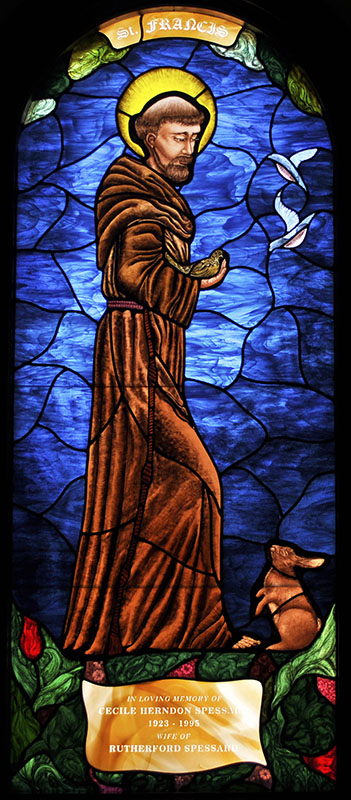 |
A memorial window for one of the members. Our challenge here was the face of St. Francis. Achieving his sweet, gaunt face took many experiments and seven firings. A wild rabbit was a part of the deceased’s daily life.
|
 |
| This photograph shows a third of the windows in this sanctuary. Using a hand-blown translucent glass from West Germany, we could blend the trees and bushes on the exterior into our concept. The striations in the glass give movement to the windows as one walks through the sanctuary. This was my first complete church project over 30 years ago.
A view of the exterior of the church. |
 This window was created to memorialize the minister’s life work at St. John’s Episcopal Church in Columbia, Virginia. I was in charge of installing the window over the back door of the small country church during the service and then taking a back-row seat in the sanctuary. When the service was over, one of the members approached the minister and announced the church had a special birthday gift for him. As the doors opened to reveal the “Guardian Angel” over the entrance doors, I don’t think I have ever seen so many tears, smiles, and joy expressed. One of the most moving experiences of my career
This window was created to memorialize the minister’s life work at St. John’s Episcopal Church in Columbia, Virginia. I was in charge of installing the window over the back door of the small country church during the service and then taking a back-row seat in the sanctuary. When the service was over, one of the members approached the minister and announced the church had a special birthday gift for him. As the doors opened to reveal the “Guardian Angel” over the entrance doors, I don’t think I have ever seen so many tears, smiles, and joy expressed. One of the most moving experiences of my career
 |
A beautiful Gothic church built in 1886 resisted stained glass all those years, feeling it was inappropriate for its all-white color scheme. We started this project by asking if we could place some sheets of glass in their windows. By “living” with stained glass, they began to appreciate the warmth and beauty it contributed to their worship area. Soon there were three donors for memorial windows, each with a desired symbol, scripture, and commemorative plaque for their loved one. |  |
 |
Simplicity can create a compelling, emotional environment by allowing us to focus on what is important to us. Symbols spark our thoughts and feelings into interpretations that are meaningful to our lives, and color heightens our senses and emotions. |  |
 |
The changing of the seasons surrounded by royal colors gives this stained glass window a balance of casualness and formality, an excellent combination for a boy’s school. We cut holes in the window about the size of a quarter and inserted chandelier parts so that rays of light travel around the chapel when the sun moves. |
 Working with the stained glass committee, we were given symbols that were important to the congregation. Many symbols were from children’s educational materials and literature collected over the years. Our job was to use our expertise and skill to interpret these symbols in art glass.
Working with the stained glass committee, we were given symbols that were important to the congregation. Many symbols were from children’s educational materials and literature collected over the years. Our job was to use our expertise and skill to interpret these symbols in art glass.




A wispy, iridescent white glass was chosen for the background for its ethereal quality. The symbols at the top were executed in stained glass, while some of the images were enhanced by painting. The beveled glass was used in the circles to add sparkle and light as if the symbols were an opening in our background of wispy white. We chose the scrolls because they gave a historical look to the scriptures. The lion and lily are just two of the many symbols we created explicitly for St. Peter Baptist Church.
 |
 |
 |
This window combines many of our studio’s most exemplary skills into a single piece. Each colored bevel couples hand-blown german glass with bevels hand-ground on our antique Henry Lang machinery. The sculpted branches, brilliant red leaves, and accent bevels give the tree an illusion of movement. The background glass is one of a kind and selected for its wispy blue and gold veins. Sliver bevels are adhered to the glass and reflect the light playfully.
To see more of this window, please visit our Facebook Page.
 |
 |
 |
Flameworking is a process we have explored in our studio, focusing on trying to capture the translucency of nature, that “sun coming through the tree limbs” effect. This dogwood tree is composed of sculpted solder, hand-made dogwood blossoms and leaves, and hand-blown german glass to bring it all alive.
 |
A European design for a traditional building. Using a light background hand blown glass from West Germany, with emerald green and beveled glass as accents, we gave this window a feel of “organized energy”. |

The 6th street Market window was created in one piece; a ten foot diameter stained glass window. To achieve this size, the reinforcing bars were a work of art unto themselves. We inserted beveled glass so the window would sparkle with the sun in the day and car lights at night. These windows are now owned by the Valentine Museum in Richmond, Virginia.
Charlottesville Business Journal:
November 1996 (.pdf | .jpg)
Richmond Times Dispatch:
September 16th, 1985 (.pdf | .jpg)
September 19th, 1985 (.pdf | .jpg)
Richmond News:
September 1985 (.pdf | .jpg)
 A twelve foot diameter skylight for a bank in North Carolina. With a concave bow we constructed this with a framework of T-bars and built the sections to fit like a drop ceiling. The trick is to bend the panels along the lead lines and brace with reinorcing bars to achieve and hold the curve.
A twelve foot diameter skylight for a bank in North Carolina. With a concave bow we constructed this with a framework of T-bars and built the sections to fit like a drop ceiling. The trick is to bend the panels along the lead lines and brace with reinorcing bars to achieve and hold the curve.

Every window begins with ideas. The ideas are worked through on paper, usually staring small and then enlarged to scale and reworked. This is the original full scale sketch of the Tandem window above. Usually, we are half way through a project before we cut the first piece of glass.

This window was created for the art room of a private school, grades 5 through 12. With the tree as their symbol, we wanted the window to express the energy, creativity, and spontaneity of the students. The tree was created using rolled stained glass with varying textures to give the effect of light filtering through the leaves. The surrounding area was created by hand beveling flash glass (a layer of color on a clear base) from West Germany. When completed, we made around 15 glass leaves with our flame-working and attached them to the window as if they were blowing in the wind.
Tandem newsletter:
December 2001 (.pdf | .jpg)
 |
We designed a mirror to go between the lighting fixtures using our “antique” mirror technique. With a thin line of emerald green reflective glass as an accent, we cut the mirror to the remaining design and placed the edges together so the light from the fixtures would travel along the edges as one moved around the room. This is commonly know as the “French Cut”. |
 |
Our client did not want the brash look of new mirrors, so by contaminating silver nitrate and rolling it around on a 2′ by 3′ sheet of glass, we created these “antique” mirrors. Cutting our sheets to size, we selected a place for each mirror around the room to achieve a balanced effect. |
 A beautiful church in Fluvanna, Virginia with several styles of stained glass that were greatly enhanced by removing the faded plastic and replacing with clear glass protective coverings, greatly improving the quality of light.
A beautiful church in Fluvanna, Virginia with several styles of stained glass that were greatly enhanced by removing the faded plastic and replacing with clear glass protective coverings, greatly improving the quality of light.
 |
Removing faded and yellowing plastic coverings and replacing them with clear tempered or safety glass with proper venting systems is an important part of what we do to preserve the integrity of our clients architecture. |

|
This is the original skylight window for a four-story stair case in the historic district of Baltimore, Maryland. Found in the basement, we were given this window to restore in hopes it would once again grace the top of the stairs. Caked with dirt and coal dust, sagging, lead joints broken, and also missing the center, we dismantled the four sides and went to work. We decided to make the center panel using a slight different, more opaque glass to lessen in the center and brighten the side panels. |
 |
 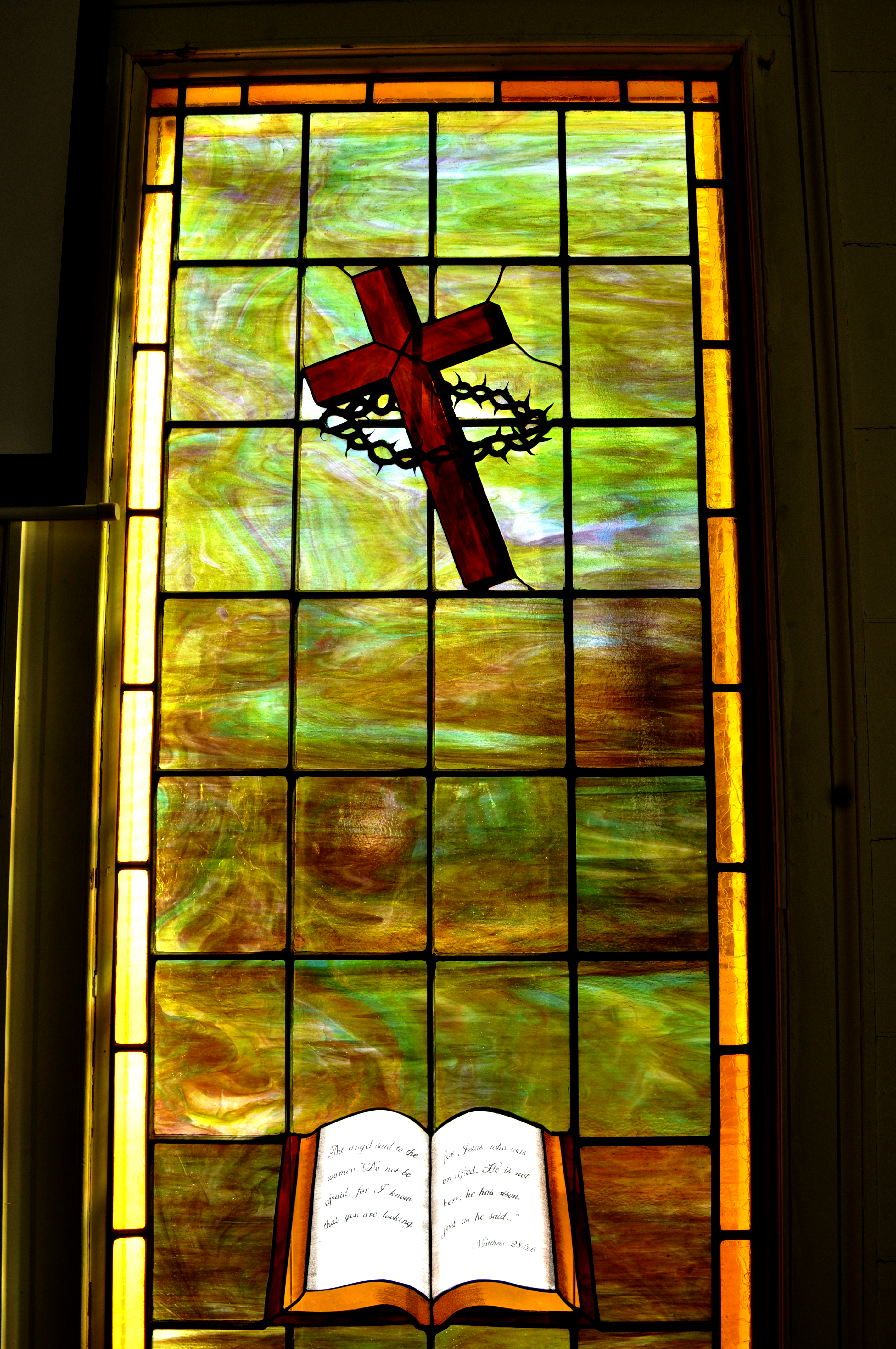  |
|
  |
|
| This is a relatively simple window in design with two significantly essential components. The crown of thorns is three-dimensional using our solder sculpting method, and the lettering on the bible is beautifully rendered as it follows the curve of the page. The green background was chosen to coordinate with the lighting fixtures and the gold to match the tassels on the American Flag. | |
 |
Along with the icon, the stained glass committee wanted thirteen contemporary stained glass windows interpreting the paintings of one of their parishioners, Mary Atkinson. Here we chose to use an adhesive to bond the stained glass to a sheet of tempered glass, removing the need for lead lines and giving us a “painted canvas” effect. |
 |
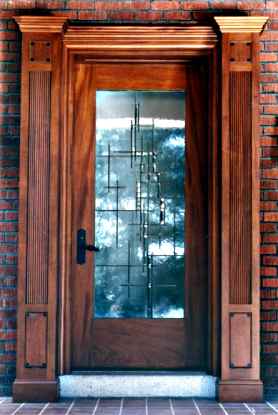 |
One of our contemporary windows where we beveled various angles on different glass thicknesses. Not symmetrical, but balanced, and with lines that reach out into the window giving an exciting and inviting feel to this traditional entryway. |
 |
 |
| A large window we created to go over a jacuzzi. With the pileated woodpecker as our focal point, we designed an overgrown and untamed tree, giving us a three-dimensional effect. This creates interest in the large area around the woodpecker, with the iridized glass picking up on the colors in the stone surrounding it. | |
 |
The iridized glass in this window blended beautifully with the surrounding colors. The delicate beveling in the tops of the trees comes alive with the lights behind them. |
 |
The couple we worked with wanted a Caribbean effect. We used antique glass with striations to give the illusion of heat waves and crystal lilies for an exotic look. |
 |
A window for over the entryway of a contemporary home. Varying lavenders picked up on the colors from the stone fireplace. The center was embellished with thin translucent glass created by our flameworking process to enhance the sun’s effect. Folding the yellow border around the window gave us an exciting alternative to a simple straight border. |
 |
Fused Glass: By cutting the glass slightly larger than the pattern, we can overlap the edges and fuse the glass in our kilns. Instead of a piece of lead holding the glass together, a seam of glass catches the light and highlights the design. As the sun moves, the light moves from one seam to another, bringing the window to life. We created eight windows like this for a beach home’s kitchen in Corolla, North Carolina. |  |

This window was created for the church choir’s practice room. Our goal was to give a windowless room a bit of the spirit to begin the early morning rehearsal.
 |
A pair of sidelights created for a couple who owns a vineyard. Here we wanted to create the effect of ice on early morning grape vines in the “dead” of winter. Hand beveling glass on our old machinery gave us the freedom to create steep, varying bevels and sculpting the vines gave them a life-like appearance. A great deal of effort went into the design to achieve the three dimensional effect with the end of the growing season branches. |
 |

I created the beveled glass door on the left for a gentleman who was starting his own real estate investment company 30 years ago. He has recently moved into a much larger office with a larger door. One of our projects this month was to modify the original glass with our 1915 Henry Lang beveling equipment and install it in the new opening.
The office staff had become quite fond of their entry door. Many consider it their signature piece.
 |
To create the effect of this landscape, we used various mediums from fine to corse to achieve the shading we needed to give this piece depth. The lettering was cut mechanically and the art work hand crafted. A nice combination in this commission. |

One of my first lampworking projects, a panel for a pool table lamp depicting the fall leaves of a Dogwood tree.
 |
Created for a couple who own an orchard, the only requirement they gave me was that it had to have an apple in it. I created an apple about the size of a 50 cent piece by flame working glass and attaching it to this window with the wintry branch. We call it “The Last Apple” |

I created this wall hanging around 1985 when I used a simple point-and-shoot camera.
I made the structure out of bronze, cut various stones for the inserts, silvered, and solder sculptured the tree area.
This was a rare attempt to create something different for a hallway where I only had reflective light to work with.
 |
By cutting strips of glass from our stock, we are able to work the glass over a flame. This gives us the freedom to manipulate the hot glass into shapes and stretch it to vary and enhance its translucency. |
 |
Iridized “turtleback jewels” were first used by Tiffany, surrounded by iridized stained glass. Plays beautifully with reflected light. |
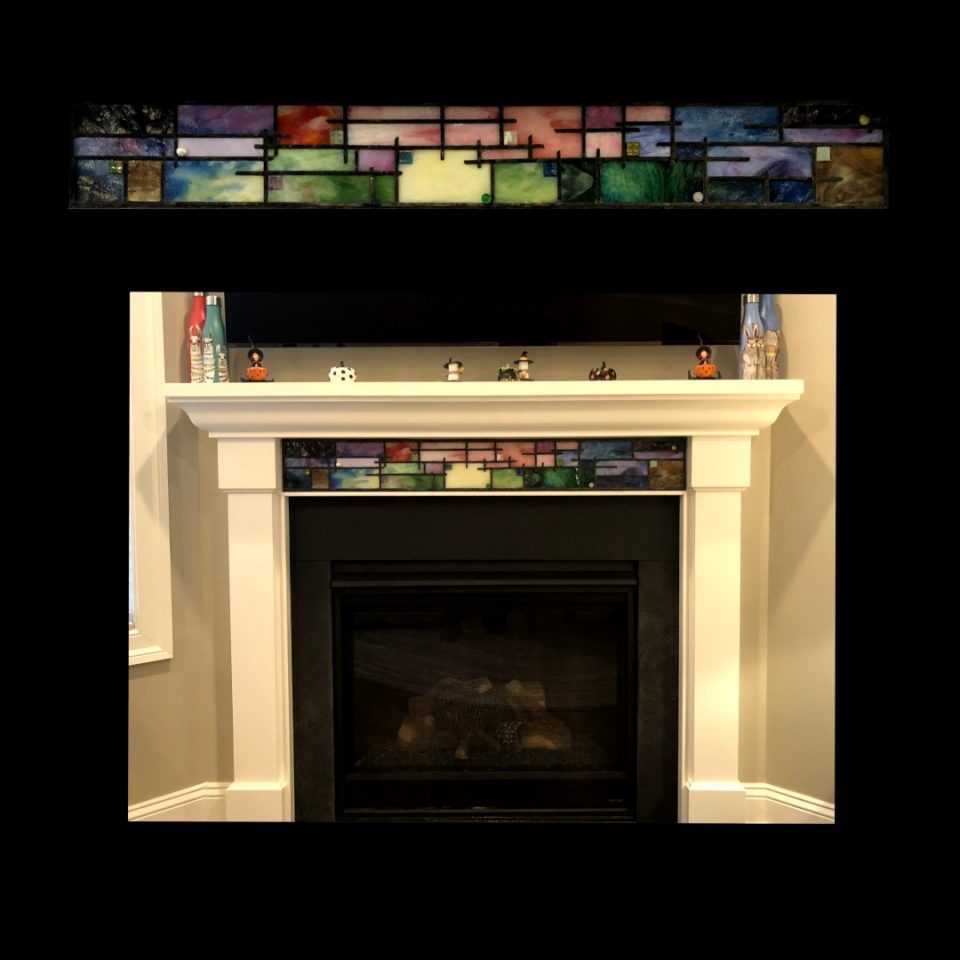
We rarely get a project where we’re only working with reflective light, and this is only the 3rd one I can remember over the last 47 years.
If you look closely, you can see the little tiles and marbles we used to give this window a playful look.
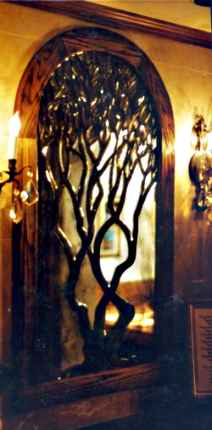 |
After hand beveling each piece of glass, we created an “antique” mirror effect by contaminating silver nitrate and silvering the back side of the glass. Then we assembled with our sculpturing technique and applied a patina for a natural look. With sconces on each side, the light reflects on the bevels as one moves down the hallway. |
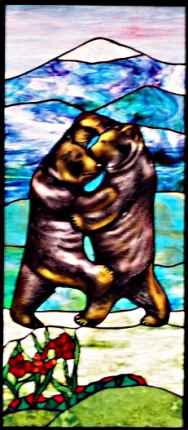 |
What a fun window. It started as a bear’s head centered in a traditional window. Evolving through our exchange of ideas, we brought this concept to life with the idea of dancing bears. Our client called one day to see how the project was going and said, “are they?” I responded, “Yes, they’re in Love.” |
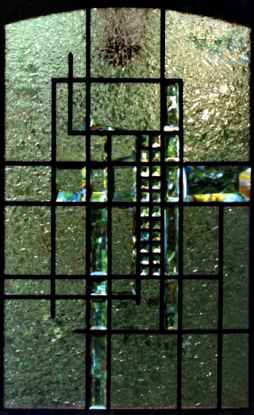 |
A beautiful example of two old glass working processes used in a contemporary way. Glue chipping and glass beveling were both developed around 1900. We can carry these traditions in our artist studio today by beveling on our 1915 Henry Lang machinery and using animal glue. |
 |
A colorful, playful stained, beveled, and sculptured window for a traditional entryway. One of a pair, these windows give an eclectic look to the foyer. |
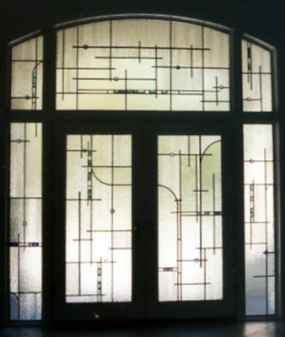 |
By adhering stained glass to the back of our bevels, we could give a jewel-like effect to the background of this textured stained glass entryway. The shadowing, created by the textures of the glass, makes this entryway especially interesting as one moves about the home. |
 |
One in a series of windows we created to simulate the vineyard’s last few days of fall. Beveling stained glass, fusing other portions, and sculpturing the solder for depth, we could bring out the piece’s true character. |
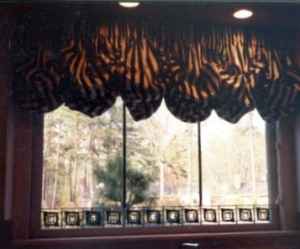 The small squares at the bottom of black beveled glass embellished the curtains above and still gave our clients their view over the kitchen sink.
The small squares at the bottom of black beveled glass embellished the curtains above and still gave our clients their view over the kitchen sink.
 One of our contemporary beveled glass windows with various beveling techniques on different thicknesses and textures of glass. The lines in the window pick up on the lines and proportions in the room.
One of our contemporary beveled glass windows with various beveling techniques on different thicknesses and textures of glass. The lines in the window pick up on the lines and proportions in the room.

A quilt-influenced design for a series of doors into a “South West” room. We used many different colors of European hand-blown glass, balanced and coordinated, to achieve the unique look our client was seeking.

After this historic Baptist church in Petersburg was vandalized, we were tasked to replicate the century-old window for this historic church. When a window is severely damaged, it is sometimes best to create an all-new duplicate. We matched the glass, made a charcoal rubbing of the original, and then started the recreation. After much hard work, the finished piece brings the entryway back to life.


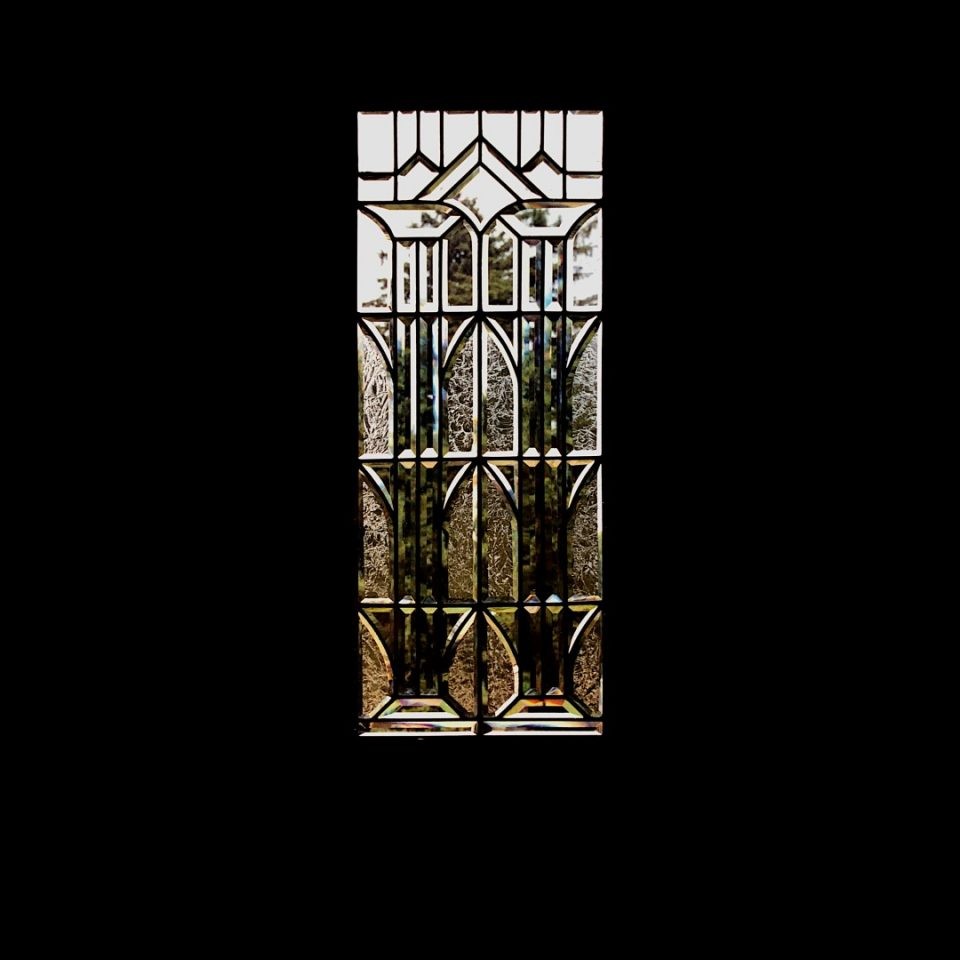
This was a series of 4 windows I created for a home in Richmond, Virginia somewhere around 30 years ago. My intention was to pick up on the design elements in the Tudor home.
This gave me an opportunity to use our 3/8″ thick glass to compliment the heavy interior wood molding and glue chipped glass, for privacy.